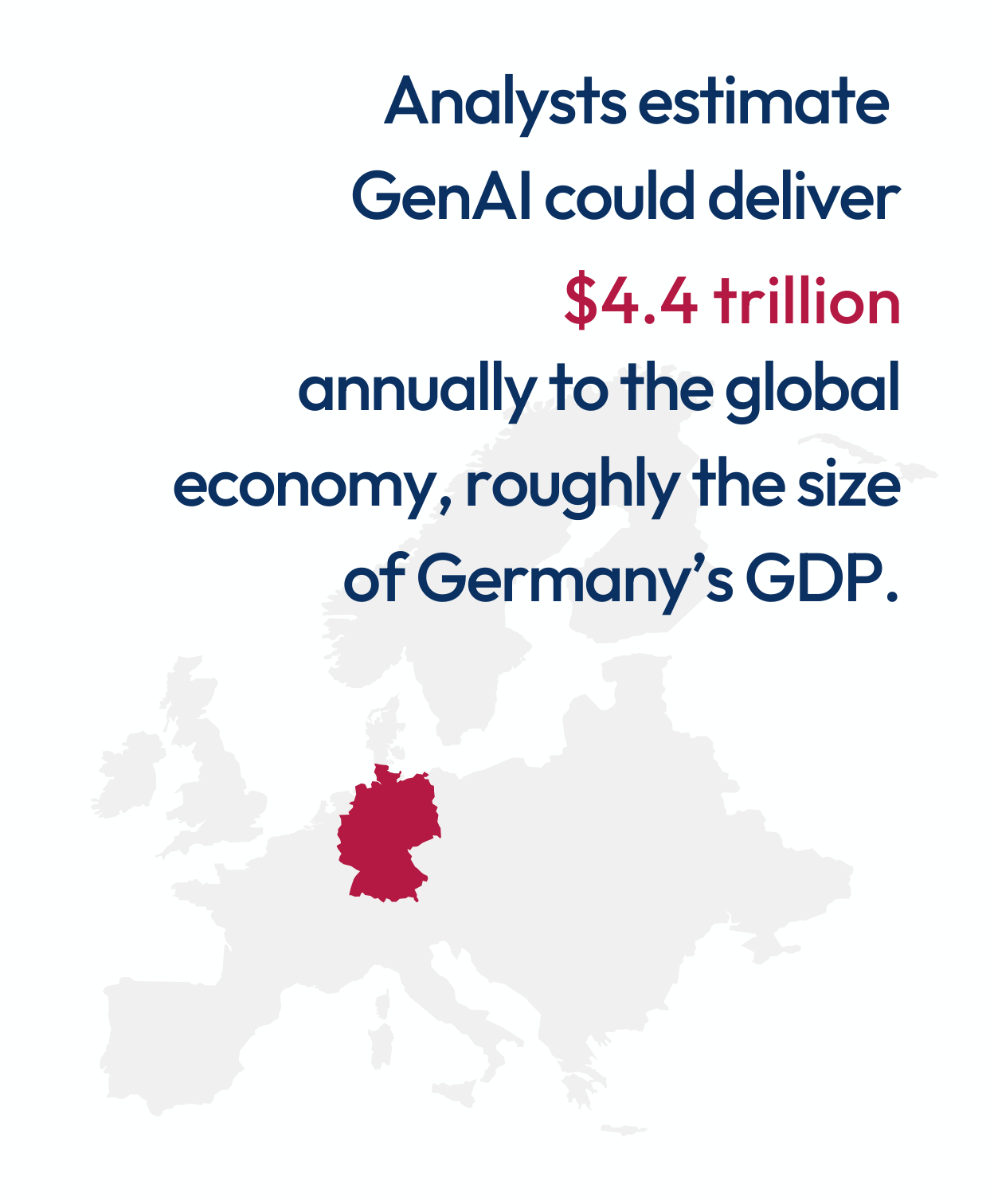Generative AI and the Implications for U.S. National Security
Hello, I’m Ylli Bajraktari, CEO of the Special Competitive Studies Project. In this edition of 2-2-2, SCSP’s Addis Goldman provides an overview of the Economy memo of our recent report, Generative AI: The Future of Innovation Power. In addition, we are launching a Lunch & Learn Live Series on LinkedIn today to dive deeper into the report. Each day at 12PM ET, we will explore a new chapter with expert members of our SCSP team. This week-long live series offers our followers an opportunity for questions and feedback. We hope you can join us!
Generative AI: The Future of Innovation Power Featured on SCSP’s NatSec Tech
Members of the SCSP team join Jeanne Meserve to summarize each memo from our fall report, “Generative AI: The Future of Innovation Power.”
In this episode, SCSP’s Brady Helwig summarizes the Building the Generative Economy Memo.
Building the Generative Economy
Generative AI (GenAI) is poised to transform the global economy. The emergence of consumer-facing “frontier” models, such as OpenAI’s ChatGPT, represents a dramatic evolution in artificial intelligence. The ultimate economic implications of generative technology — and its continuous development and diffusion — remain unclear. However, even at this early stage, GenAI is expected to advance the information age in ways comparable to the dawn of the open internet.
Analysts estimate that GenAI could deliver $4.4 trillion annually to the global economy — roughly equivalent to the annual economic output of Germany. Countless businesses are already harnessing GenAI to improve products and services, while generative technology is leading to scientific breakthroughs that would “otherwise take decades,” promising significant downstream economic benefits.
As with previous general-purpose technologies, GenAI could rapidly accelerate the rate of technological change, enabling a “flywheel of innovation” that drives productivity and efficiency gains across industries. Although genuine concerns have been raised about the potential for GenAI to displace workers, in the long-run, automation technologies tend to complement human labor and create new professions and industries.
GenAI has hardly emerged in a vacuum. As governments around the world invest in technology competitiveness and pursue “de-risking” strategies to increase resilience, GenAI has moved to the forefront of strategic competition between the United States and the People’s Republic of China (PRC). We should expect America’s most determined competitor for technology leadership to devote vast resources to developing indigenous GenAI capabilities. The PRC leadership understands the economic significance of AI and has a history of leveraging its scope and scale — and employing “brute force” tactics — to achieve dominance in sectors that are critical to competitiveness and economic security. Given the PRC’s national strategy of Military-Civil Fusion (MCF), which seeks to ensure that breakthroughs in civilian research and commercial sectors advance Beijing’s military and economic objectives, Washington has no room for complacency.
At present, the United States enjoys significant advantages in GenAI. For a start, American tech-giants, from Meta to Microsoft (OpenAI), have released the most popular consumer-facing frontier models (ChatGPT, for example), and are investing heavily in GenAI. Meanwhile, venture capital firms are pouring tens of billions of dollars into the U.S. AI ecosystem, with over $14 billion invested in U.S. AI companies in the last twelve months. In addition, through the CHIPS and Science Act and related initiatives, Congress and the Biden administration have enhanced U.S. semiconductor manufacturing capacity and attracted more than $200 billion in private capital investments for semiconductor production. TSMC, far and away the world’s most dominant fabricator of AI chips, has invested $40 billion in manufacturing facilities in the United States.
The Building the Generative Economy memo outlines a strategy to consolidate U.S. leadership in GenAI and, in collaboration with allies and partners, shape the global balance of techno-economic power in favor of democratic market economies for decades to come. This strategy begins with bolstering competitiveness across the building blocks of AI leadership: Compute, Data, People.
Compute, or access to clusters of advanced AI chips, is what underpins GenAI development. Building and maintaining AI models requires massive amounts of computational power. Since 2012, the amount of compute resources needed to train AI models has increased by roughly 55 million times.
U.S. advantages in GenAI begin here. Nvidia, the world’s leading designer of AI chips, is based in the United States, as are its largest competitors. Meanwhile, U.S. firms dominate the cloud computing business, and export controls on AI chips and semiconductor manufacturing equipment, applied in concert with key allies in the Netherlands and Japan, give Washington a powerful lever to slow Beijing’s ambitions to secure compute dominance.
Despite existing U.S. compute advantages, in order to sustain innovation at the GenAI frontier, the United States must ensure that researchers have access to compute resources via cloud providers, encourage sustainable AI techniques, protect U.S. advantages in microelectronics, and lead in developing novel hardware paradigms. Action steps include:
Create the National Artificial Intelligence Research Resource (NAIRR). Policymakers in Washington should work to guarantee that academic researchers have ample access to cloud-based computing resources. The NAIRR program would seek to ensure that they do. If authorized, the program should be funded as quickly as possible at $2.6 billion over six years. The purpose of the NAIRR would be to bridge the critical gap between academia and the private sector, enabling academic research to find commercial applications.
Launch moonshot projects focused on incentivizing investments in emerging compute paradigms that could power future generations of AI models. In addition to launching the National Semiconductor Technology Center (NSTC) — already funded under the CHIPS and Science Act and scheduled to launch later this year — with appropriate national ambition, the NSTC Investment Fund should be resourced with significant government seed funding and serve as a “help desk” for innovators as they attempt to navigate the public-private ecosystem.
Data, plus the digital infrastructure needed to query, process, and transport it to and from connected devices and users, is essential to AI leadership. The United States has long enjoyed significant advantages in data access for training the most sophisticated AI models, largely owing to the global presence of U.S. tech firms and large volumes of English language text on the Internet. The United States also has more data centers than any other country and dominates the big data analytics market.
China, however, is making gains with a comprehensive strategy that restricts access to its large domestic data resources and leverages its tech firms’ growing global footprint to access global data resources. The PRC has also made significant strides in developing and exporting the next generation of data infrastructure and advanced network technology. Meanwhile, disagreement over U.S. and EU approaches to data regulation threatens to dampen innovation and limit opportunities for enterprising firms.
In order to maintain its competitive advantage in data access, the United States must resolve uncertainty around regulatory issues like data privacy and ownership, make valuable government data more accessible, and create public-private partnerships to aggregate siloed datasets for strategic effect. In short, the U.S. should leverage data as a strategic asset by developing coherent approaches to digital infrastructure and data governance.
Pass comprehensive data privacy legislation. As diverse industries seek to harness AI, a data governance model will be instrumental in efforts to establish checks and balances that ensure data and technology are used ethically, safely, and in keeping with our nation’s values. Legislation is required to unify the patchwork of state laws and enable trust in the U.S. data ecosystem to set conditions for new digital trade agreements. By defining legal requirements surrounding data usage, the United States can maximize data as a strategic asset while protecting privacy rights and mitigating social harm.
Develop a National Strategy for Digital Infrastructure. Congress has appropriated more than $100 billion for digital infrastructure since 2018, but the United States lacks a coordinated approach to strengthen America’s digital backbone. In particular, the United States must position itself to win the competition for the next generation of advanced networks by prioritizing industrial and enterprise use-cases. Wireless networks will be especially crucial as the proliferation of GenAI-powered applications increases data flows at the edge.
People are America’s most important asset for AI competitiveness. Leadership in generative AI requires the ability to attract and retain the “rare talent to make AI breakthroughs” – the “holy grail” for enhancing U.S. national competitiveness. While the United States remains an attractive destination for technical experts, increasing numbers of high-skilled immigrants are choosing to take their talents elsewhere due to the administrative burdens of the immigration system. In addition, providing high quality STEM education and pathways for reskilling and training is vital to realizing the productivity benefits of general purpose technologies and creating opportunities for the American workforce.
Increase the H-1B visa cap. Talented immigrants have always played a key role in America’s innovation ecosystem. This is especially true in the AI space. Sixty-five percent of America’s top AI companies have immigrant founders or co-founders. The United States must act quickly to create new pathways to attract AI talent from around the world. A comprehensive strategy from the Departments of Labor and Homeland Security is required to improve the H-1B system and, in collaboration with Congress, recommend a cap increase to 195,000.
Form a National Commission on Automation and the Future of Work. The diffusion of GenAI could deliver dramatic productivity benefits. But at this early stage, it remains unclear how the pervasive deployment of these capabilities will affect labor markets and the nature of work in the long run. To unlock new opportunities for the American workforce, economic policymakers should invest in and update worker training and development programs that are adaptable to the rapidly evolving nature of GenAI. To this end, the federal government should form a bipartisan commission to review the current state of automation in the United States, analyze its impact on our workforce and economic competitiveness, and propose policy changes that address human-machine teaming, upskilling, and reskilling.
The emergence of generative AI at commercial scale marks a fundamental economic turning point. Nations that lead in the adoption and development of GenAI will reap the long-term benefits of increased productivity and economic growth – both of which translate to additional resources for national priorities, from defense spending to R&D and social programs. GenAI also marks an opportunity to open digital markets among allies and partners who treat data as a strategic asset that can be leveraged to enshrine democratic values. Without a focused effort, however, enduring U.S. leadership in this emerging sector cannot be assured. By shoring up the essential building blocks that underpin AI leadership, the United States can ensure democratic competitiveness in the Age of AI.








